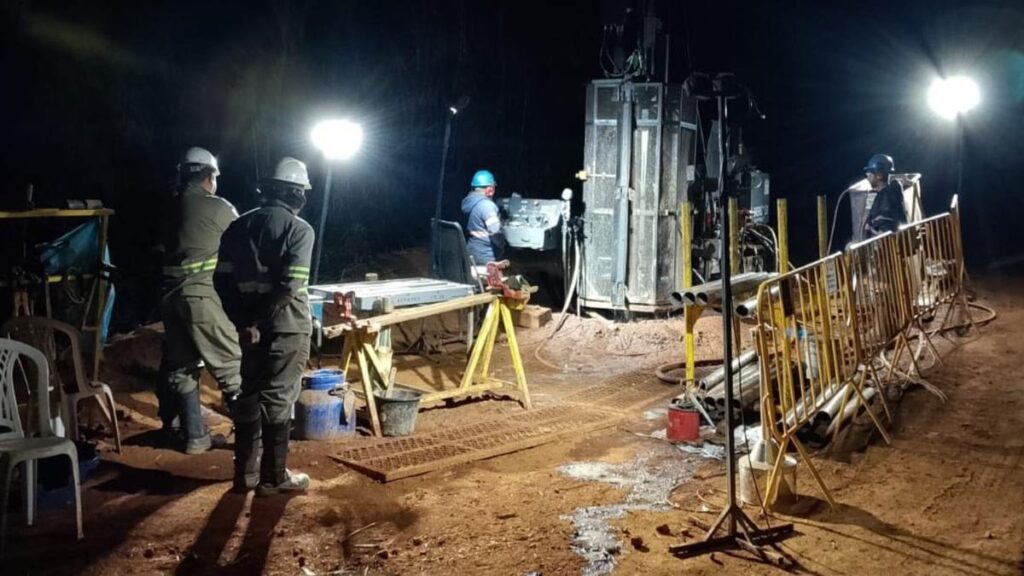St George Mining has backed up its maiden diamond drilling success in Brazil with another impressive hit, intersecting 87.7 metres at 2.95 per cent total rare earth oxides (TREO) and 0.41 per cent niobium oxide from just 2 metres depth at its Araxá project in Minas Gerais.
The intercept was cut from a large step-out hole drilled 150m west of the company’s current JORC-compliant resource, confirming that mineralisation extends well beyond the boundary of the existing massive 40.6 million tonne resource grading 4.13 per cent TREO and 0.68 per cent niobium pentoxide.
Araxá is already one of the largest and highest-grade rare earths and niobium resources in the Western world and the biggest of its kind in South America.
Notably, assays from the new hole show the key magnet rare earths – neodymium and praseodymium (NdPr) – make up almost 31 per cent of total rare earths content, pointing to a valuable mix of elements critical for high-performance metals used in electric vehicles, wind turbines and defence systems.
The new hole lies just 115 metres north-east of St George’s first step-out diamond hole – drilled 230m west of the main resource – which last week delivered a stunning 98 metres at 3.07 per cent total rare earth oxides (TREO) and 0.43 per cent niobium pentoxide right from surface. That standout hit also included 10.4 metres going 5.48 per cent TREO from 4.6m and another 12 metres grading 4.04 per cent TREO from 25m.
Between the two step-out holes, St George is rapidly sketching the shape of a thick, continuous blanket of rare earths and niobium mineralisation sweeping through the weathered saprolite. The twin hits paint a clear picture of a big, fertile carbonatite system growing to the west – one that looks increasingly capable of turning Araxá into a world-class discovery.
The results from our second diamond drill hole continue to support the potential for a substantial increase in the scale of high-grade rare earths and niobium deposits at the Araxá Project.
Management says the rigs are now humming around the clock, with three diamond rigs and a reverse-circulation unit working flat-out to stretch Araxá’s footprint and chase the system both laterally and at depth.
Fresh assay results are only weeks away, with detailed mineralogical and metallurgical studies next in line to map out exactly how the prized magnet rare earths are distributed throughout the orebody.
Beyond the drill bit, St George holds a prime seat in Brazil’s mining heartland. Araxá sits right next door to CBMM’s world-famous niobium operation and enjoys first-class infrastructure, a deep local talent pool and firm government support.
Adding to the tailwinds, the company has also been tapped for Brazil’s MAGBRAS – an initiative to build a homegrown rare earths magnet supply chain – and has a fast-track approvals pact with the State of Minas Gerais.
Rounding out the company’s growing credentials, St George recently completed a jumbo $72.5 million capital raising starring a lead role from Gina Rinehart’s Hancock Prospecting, which put up $22.5m.
With two thick, high-grade hits already in hand, a fully funded and aggressive drilling campaign under way and early government support secured, St George Mining’s Brazilian adventure looks to be shaping into something that is going to turn heads.
The Araxá project could soon emerge not just as a major new rare earths discovery, but as a cornerstone in the Western world’s drive to secure critical mineral supply chains beyond China.
Is your ASX-listed company doing something interesting? Contact: matt.birney@wanews.com.au
https://thewest.com.au/business/bulls-n-bears/st-george-nails-massive-87m-hit-of-high-grade-rare-earths-in-brazil-c-20447840


